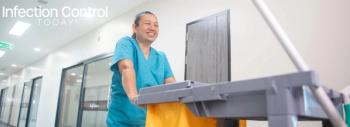
New AAMI Standards Impact the CS/SP Department
New AAMI Standards Impact the CS/SP Department
By Frank Sizemore, ACSP, BS
The Association for the Advancement of Medical Instrumentation (AAMI)produces recommended practices for sterilization that upon implementation canmake a significant impact on the daily life of the central service (CS) orsterile processing (SP) department. The standards, developed by industryleaders, professional organizations, interested users and consultants, are meantto provide guidelines to aid CS/SP departments in providing safe and effectivepatient care. The documents are periodically reviewed to assure the informationis still valid and necessary. Since they are consensus documents, significantdiscussion and debate normally transpire during the review process.
The most recent document to be completed is Steam Sterilization and SterilityAssurance in Healthcare Facilities (ST46). This document, originally called GoodHospital Practice: Steam Sterilization and Sterility Assurance, was lastapproved by the American National Standards Institute (ANSI) in November 1993.The new document, which should be available for purchase soon, has been expandedin several areas to include new information.
The revised document contains information regarding the differentclassifications of chemical indicators (CI). AAMI currently recognizes fiveclasses:
- Class 1 (process indicator): chemical indicator intended for use with individual units (e.g., packs, containers) to demonstrate that the unit has been exposed to the sterilization process and to distinguish between processed and unprocessed units
- Class 2 (Bowie-Dick test indicator): chemical indicator designed for use in a specific test procedure (e.g., the Bowie-Dick test)
- Class 3 (single-parameter indicator): chemical indicator designed to react to one of the critical parameters of sterilization and to indicate exposure to a sterilization cycle at a stated value of the chosen parameter
- Class 4 (multi-parameter indicator): chemical indicator designed to react to two or more of the critical parameters of sterilization and to indicate exposure to a sterilization cycle at stated values of the chosen parameters
- Class 5 (integrating indicator): chemical indicator designed to react to all critical parameters over a specified range of sterilization cycles and whose performance has been correlated to the performance of the stated test organism under the labeled conditions of use
This type of information is extremely important to the CS/SP professional. Intoday's legal environment, many of us are concerned about under monitoring oursterilization loads. The standard has been the same for years -- biologicallymonitor at least weekly, preferably daily. An implantable device should bebiologically monitored, and if possible, quarantined until the results areavailable. Those who have been involved with a product recall as a result of apositive biological know the expense and headaches associated with attempting toaccount for each item. Since recall procedures stipulate that all items bepulled since the last negative biological indicator, if the biologicalmonitoring were done weekly, the majority of those items would have been used.Given that, the majority of hospitals are doing at least daily monitoring, and afew hospitals are monitoring every load. In today's economic environment, we arekeenly aware of the expense of biologically monitoring every load. Given theimpact of decreasing reimbursement to healthcare facilities, CS/SP professionalsare often charged to providing a certain level of service while staying withinfiscal budgets.
One option to maintain service and costs is to use an integrating indicator(a Class 5 device), which is correlated to a biological indicator, to monitorevery load. This provides the CS/SP professional and the healthcare facility theopportunity to issue supplies with a higher level of confidence. Using anintegrating indicator does not eliminate the need for biological monitoring.This should continue based on your policies, established by the infectioncontrol and safety committees. Additional information concerning chemicalindicators can be found in ANSI/AAMI ST60, Sterilization of Healthcare Products-- Chemical Indicators Part 1: General Requirements.
Another significant area of the document to be expanded is the biologicalindicator section. Since this document was last updated, an addition ofenzyme-based biological indicators with early readout capabilities becameavailable. This capability allows the user to release loads in as little asthree hours for prevaccum cycles -- a significant improvement over the previous48-hour incubation period. Since these indicators use a naturally occurringenzyme, it is important to periodically "grow out" the culture. Simplyfollowing the manufacturer's recommendations should be adequate.
As stated earlier, the AAMI recommended practices are an important part ofthe CS/SP professional's resources. Since the AAMI documents evolve with time,the steam-sterilization working group is currently creating a new paper thatcould incorporate a number of different documents. This new document, designedto cover all aspects of the steam sterilization process, will include thefollowing: Steam Sterilization and Sterility Assurance in Office-Based,Ambulatory-Care Medical and Dental Facilities (ANSI/AAMI ST42:1998), SteamSterilization and Sterility Assurance in Healthcare Facilities (ANSI/AAMIST46:2002), Good Hospital Practice: Flash Sterilization-Steam Sterilization ofPatient-Care Items for Immediate Use (ANSI/AAMI ST37:1996), Good HospitalPractice: Guidelines for the Selection and Use of Reusable Rigid SterilizationContainer Systems (ANSI/AAMI ST33:1996). Its title will be Comprehensive Guideto Steam Sterilization and Sterility Assurance in Healthcare Facilities (ANSI/AAMIST37). As you can tell, this will be an encompassing document and will require agreat deal of work to complete.
For an undertaking like this to be truly effective, it is imperative to haveuser feedback. Many of the working groups have a small number of users actuallycontributing to the documents as they are developed. My challenge to you is tobecome involved, provide feedback and make these documents usable for yourneeds.
Frank Sizemore, ACSP, BS, is manager of central services at Wake ForestUniversity Baptist Medical Center in Winston-Salem, N.C. and is president-electto the American Society for Healthcare Central Service Professionals (ASHCSP).
Newsletter
Stay prepared and protected with Infection Control Today's newsletter, delivering essential updates, best practices, and expert insights for infection preventionists.





